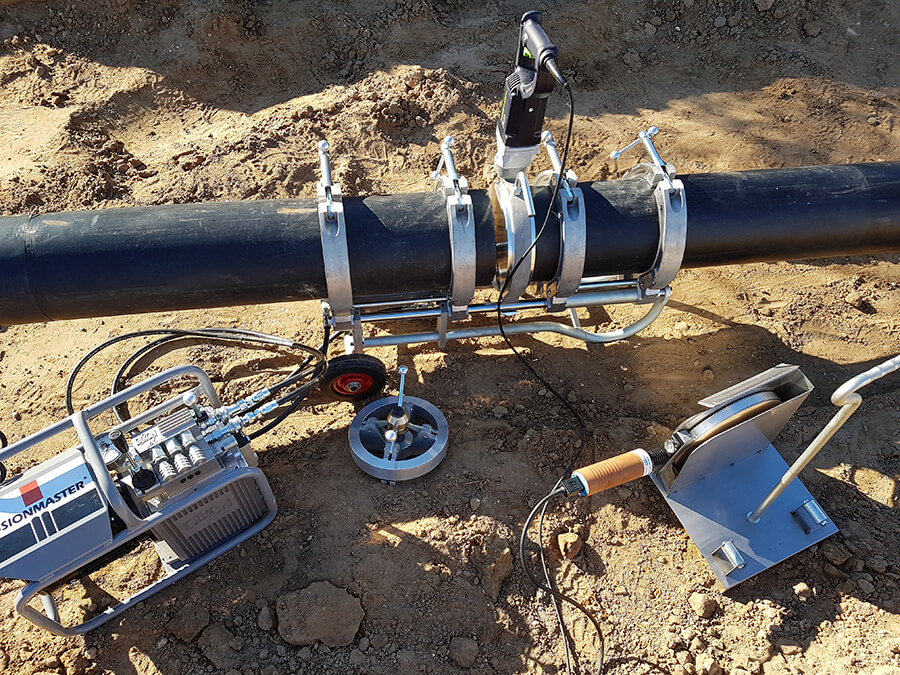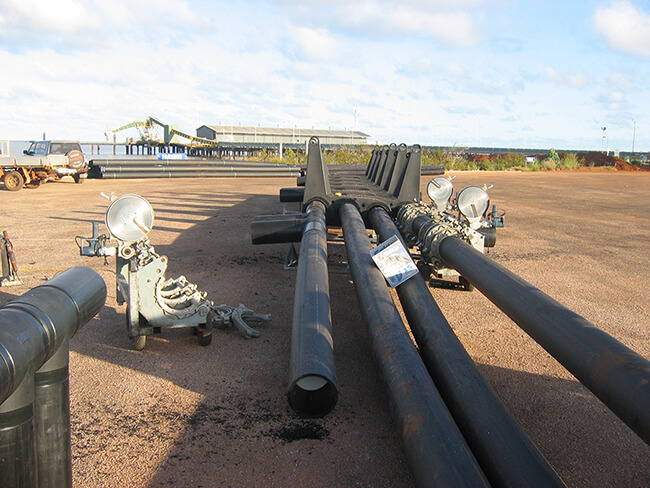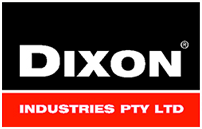Poly Pipe Welding
The butt welding method of joining polyethylene (PE) pipe requires the combined application of appropriate temperature, time and pressure to ensure a sound weld.
Operators should take care to determine the suitability of materials for butt welding. Join only pipes and fittings made from the same raw materials, eg PE to PE, PP to PP, PVDF to PVDF etc.
The joint area must always be protected from adverse weather conditions, eg dampness, excessive cold or heat, or strong winds which could lead to the pipe wall developing non-uniformly heated zones.
The weld zone should be free of bending stress, free of notches or similar damage and be free of contamination.

FUSIONMASTER HDPE Poly Pipe Welding.
The basic welding process
a) Prepare the ends of the pipe or fittings so they are clean and parallel to each other.
b) Heat the ends to melt the plastic until a bead just forms round both ends.
c) Heat soak the ends for a prescribed time.
d) Remove the heater plate and bring the pipe ends into contact with each other.
e) Raise the pressure gradually to prescribed weld pressure.
f) Maintain pressure until weld cycle is complete, before unclamping and removing pipe from the machine.
Weld failure troubleshooting
 Uniform bead
Uniform bead
Correct welding.
 Crack down centre of bead
Crack down centre of bead
“Cold weld” signified by clean break through the middle of the weld with a smooth appearance.
Could be due to insufficient heat soak time or temperature, changeover time too long, excessive soak pressure, insufficient fusion pressure, no allowance for drag pressure, or drag pressure too great eg due to pulling pipe up a gradient.
 Misalignment
Misalignment
Maximum allowable 10% of wall thickness.
Care should also be taken to ensure pipes or fittings being joined have the same diameter and wall thickness or the probability of weld failure is significantly increased.
 Insufficient bead roll
Insufficient bead roll
Could be due to insufficient heat soak time or temperature, changeover time too long, insufficient fusion pressure, or no allowance for drag pressure.
 Unequal bead size
Unequal bead size
Look for temperature gradients eg pipe surface in the hot sun vs pipe in the shade, or heater plate hot spots. Look for unequal application of pressure. If unequal uniformly around the whole circumference, look for physical difference in materials being joined eg melt flow index.
Butt welding equipment is designed to apply the temperatures and pressures specified by the parameters. As the conditions of use of welding equipment are outside the control of Dixon Industries, no warranties are expressed or implied and no liability is assumed in connection with the use of butt welding equipment or the butt welding guidelines or parameters.
PIPA Industry Guidelines for Butt Fusion Jointing of PE Pipes & Fittings
PIPA recommends the butt fusion procedures and parameters as specified in ISO 21307, Plastics pipes and Fittings – Butt Fusion Jointing Procedures for Polyethylene (PE) Pipes and Fittings Used in Construction of Gas and Water Distributions Systems.
ISO 21307 specifies three proven butt fusion jointing procedures for pipes and fittings, taking into consideration the materials and components used, the fusion jointing procedure and equipment and the quality assessment of the completed joint. It also covers the weld procedure for activities such as surface preparation, clamping, alignment and cooling procedures.
Butt welding involves the heating of two pipe ends to fusion temperature and then subsequently joining the two ends by the application of force.

FUSIONMASTER Butt Fusion Welders
However, a successful butt weld requires the correct combination and sequence of the welding parameters time, temperature and pressure.
ISO 21307 contains three distinct fusion methods described below for pipe and fittings.
It is essential that the parameters specified for a given method are followed. Do not mix and match parameters from each method.
Single pressure – low fusion jointing pressure
This method has been used by most European countries and in Australia.
Dual pressure – low fusion jointing pressure
This method is used by the water industry in the UK, and in Europe for pipe with a wall thickness greater than 22mm. These parameters are not commonly used in Australia.
Single pressure – high fusion jointing pressure
This method has been used extensively in Northern America and more recently in Australia for the construction of gas gathering pipelines. The weld interface pressure is approximately three times the low pressure method and, as a consequence, more of the molten material is extruded from the weld zone, thereby enabling a reduced cooling time. The method is relatively new in Australia and therefore extra attention is required to ensure that:
- Welding machines have sufficient structural strength and hydraulic capacity to achieve the high pressure parameters in a safe manner. Confirmation should be sought from the machinery manufacturer.
- The welding operator is sufficiently experienced and proficient with the parameters.

